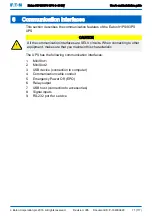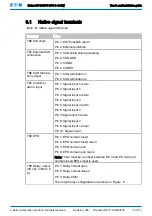
9.
Connect the internal batteries.
5.2 Battery system installation
DANGER
This UPS may have internal batteries. The batteries are designed to deliver a
large amount of energy and an incorrect connection may lead to a short
circuit and cause serious injuries to the personnel or damages to the
equipment. In order to avoid damages to the equipment or injuries to
personnel, only commissioning personnel are allowed to perform the
connection of these batteries.
Note: The 91PS/93PS UPS C-model does not have internal batteries. In the
C-model, the internal battery breaker CB1 is used for disconnecting external
batteries from the UPS power module. See Section
how to install an external battery cabinet.
If you are installing a customer-supplied battery system, install the battery
system according to the battery and battery system manufacturer’s instructions
and all the applicable national codes and regulations. Only qualified personnel
may install the battery system. Battery cables must be protected against current
and thermal overload, that is, the battery system must include proper fuses or
breaker with protection function. Ground the external battery cabinet to the UPS.
The default battery settings of the UPS are for 12 V VRLA batteries. If you need
to use any other type of batteries, contact your Eaton representative. For the
battery specification, see Section
.
5.2.1
Battery trip wiring
The 91PS/93PS UPS units are always equipped with an internal battery
breaker, which affects only the UPS internal batteries. The external battery
breaker is a crucial part of the external battery cabinet or rack and must be
placed in it. With the external battery breaker, signal cabling is important.
Both internal and external battery breakers can be tripped (switched off) by
energizing its shunt trip coil. The shunt trip coils of external battery breakers are
Eaton 91PS/93PS UPS 8–40 kW
User's and installation guide
©
Eaton Corporation plc 2018. All rights reserved.
Revision: 005
Document ID: P-164000493
58 (117)






























